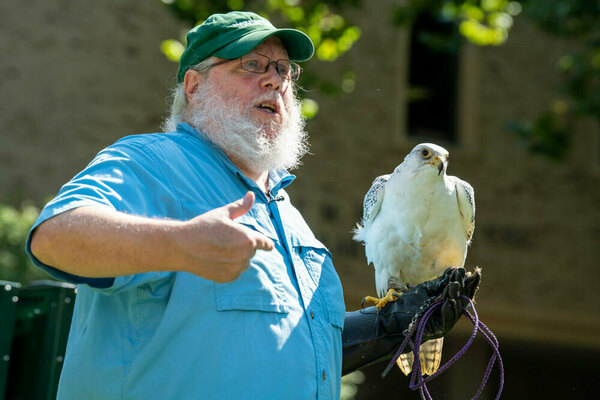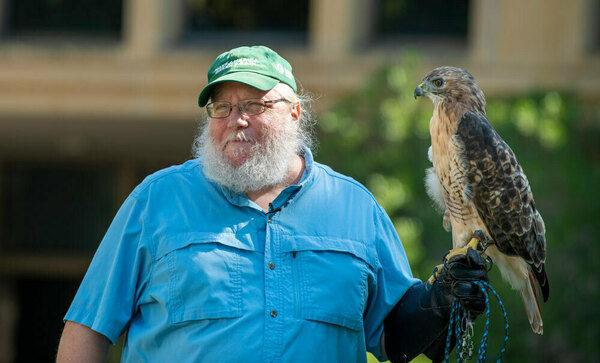Falcons and Hawks Visit Notre Dame for Medieval Institute Tailgate

Mark Booth, Royal Falconer and director of Take Flight! Wildlife Education, visited Notre Dame on Saturday, September 18th, for the Medieval Institute's second 75th Anniversary home game event. He brought three feathered friends with him: a Red-tailed Hawk named Rose, an American Kestrel named Flint, and a Gyrfalcon named Elsa.
The event began with a tailgate buffet and an introduction by Dr. Christopher Liebtag Miller, who talked about how falconry spread from Asia to Europe in the Middle Ages. Falcons became popular both as a way to hunt and as an image in poems of the period. As Miller said, "The falcon is a bird of the imagination," able to represent the dynamism of human nature.

Booth gave the audience a ground rule: "Be chill around the birds." He then introduced Rose, a three-pound Red-tailed Hawk. He discussed her annual molting, sharp talons, and wings intended for soaring. After feeding Rose some mice from his pockets ("I always need to check my pockets before I do laundry!"), he returned her to her dark carrying box.
He next taught the audience several ways of distinguishing between falcons and hawks, which are in two different genuses. Hawks, dieting on ground animals, have wings shaped for soaring, while falcons, as bird-eaters, have wings shaped for dexterity and speed.
 The crowd enjoying Rose and Mark present. Photograph by Barbara Johnson.
The crowd enjoying Rose and Mark present. Photograph by Barbara Johnson.Booth also discussed the possible falconry origins of common phrases, like "hoodwinked" and "old hag." Falcons often wear hoods or are housed in dark boxes in order to stay calm. Falconers claim that "old hag" as a term comes from the idea of a haggard bird, an adult with full plumage who is more difficult to train. Widows whose husbands died in the Crusades were called "old hags" to compare them to these birds. Next, Booth introduced the crowd to an eight-year-old, 5-ounce American Kestrel (a small falcon) named Flint. Lastly, Booth brought out Elsa the Gyrfalcon. He explained that Gyrfalcons are the largest species of falcons, and come from the Arctic.
Vikings would catch and trades Gyrfalcons, and they became a status symbol owned by kings in the Middle Ages, when falcons were only flown by the nobility. One's rank determined the kind of falcon a person could use: Gyfalcons for the king, Peregrine Falcons for upper nobility, Saker Falcons for knights, and Merlins for women.

Falcons now, rather than indicating status, can indicate the health of an ecosystem. Placing Elsa back in her container, Booth urged the audience, "Learn more about nature and about history, because you're a part of both." The audience, full of laughter at Booth's bird-related puns and exclamations at the majestic wildlife, certainly seemed to agree.
Read more about our planned events, which include medieval-themed presentations before every home game this fall.